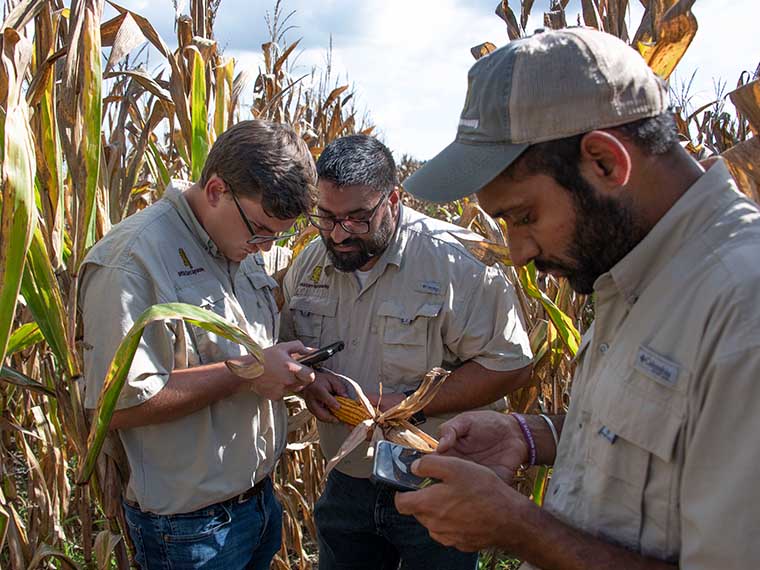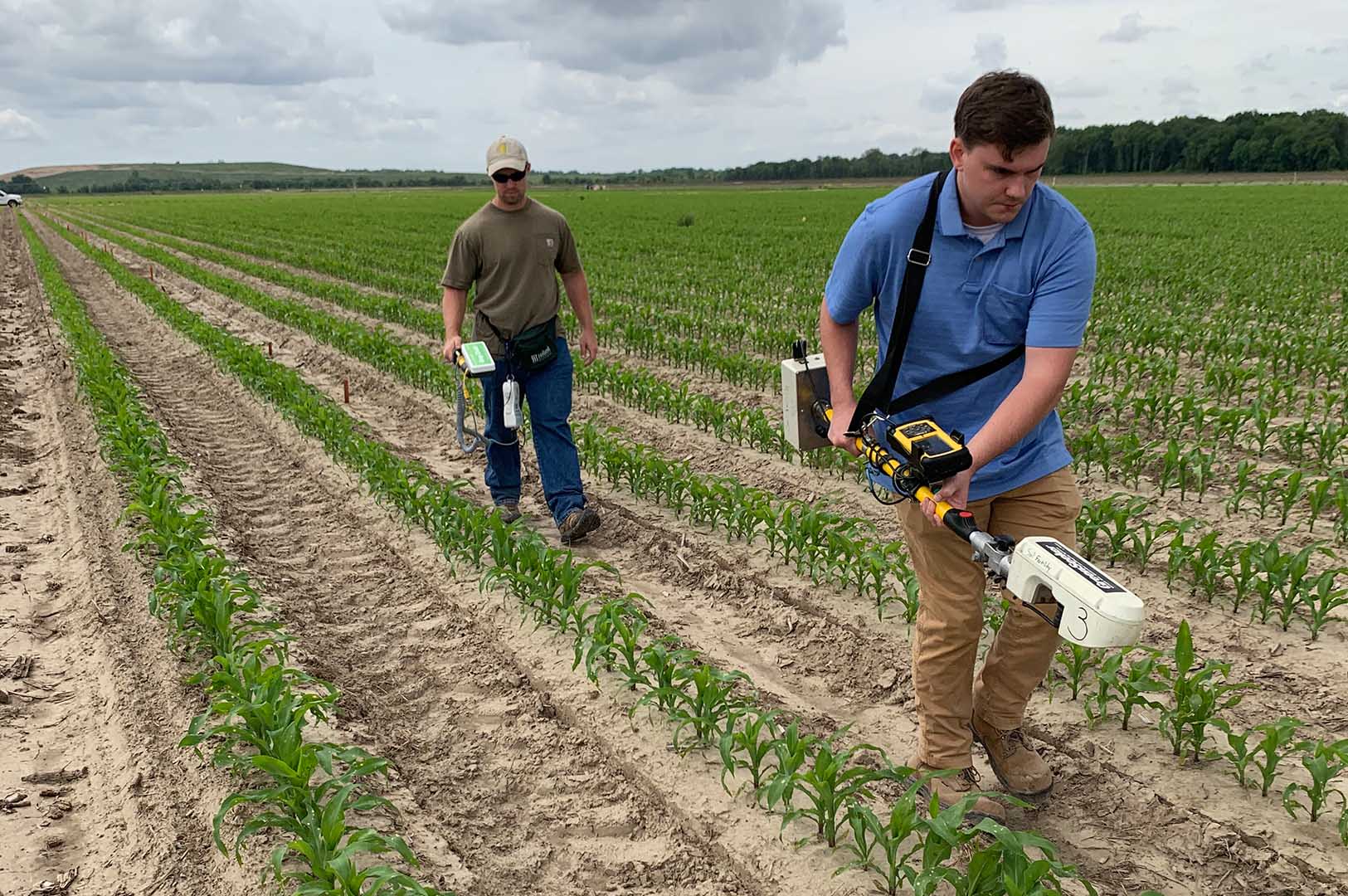The Maze of Maize
Using Optical Sensors to Predict Nitrogen and Sulfur Deficiency in Corn
By: Meg Henderson
The information presented on this page may be dated. It may refer to situations which have changed or people who are no longer affiliated with the university. It is archived as part of Mississippi State University's history.
Sulfur is a key macronutrient required to grow a healthy crop of corn. If you see a plant with light green or striped leaves, slow growth, or delayed maturity, it may not be getting enough sulfur into its root system.
Dr. Jagmandeep Dhillon, MAFES scientist and assistant professor in the Department of Plant and Soil Sciences, leads a team of MSU researchers in a twofold investigation. One goal was determining how nitrogen affects sulfur levels in corn plants and vice versa. At the same time, they investigated the use of optical sensors to predict sulfur deficiency in the plants.
Over the last few decades, sulfur deficiency has been an increasing problem for corn farmers. Dhillon explained that three main factors contribute to sulfur deficiency in agricultural soil worldwide. First, modern farming practices have simultaneously depleted sulfur in the soil and placed greater demands on the soils.
"When we began tilling our fields, the continuous tilling of the soil has gradually reduced the organic matter content in the soil," Dhillon said. "At the same time, as crop yields have increased, demand for nutrients has increased as well. The soil is unable to support this demand and to compensate, fertilizers are applied to keep up."
Changes in the air, as well as on the ground, have diminished the amount of sulfur in soil, at least in the U.S. The Clean Air Act of 1990 resulted in much cleaner air, but it also resulted in less sulfur in the soil. Prior to this act, the sulfur dioxide emitted by coal-burning power plants, when mixed with rain, would deposit 20-30 kilograms per hectare into the soil, according to Dhillon.
In addition to a reduced natural amount of sulfur present in the soil, most of the sulfur added to fertilizer is not absorbed by plants. In a 2019 study, Dhillon and his colleagues applied a sulfur-based fertilizer to cereal crops and found that the plants took in only 18 percent of the sulfur applied.
"Sulfur can leach through the soil with water, especially during times of excessive rainfall, and there are other pathways for it to be lost to the environment," he said.
In attempt to counteract the poor efficiency of this nutrient and the many factors that collectively deplete it from farmland soil, consumption of sulfur-based fertilizers is increasing at a rate between three and five percent each year, depending on the usage and management of the field.
"When we talk about fertilizer recommendations, nitrogen is the nutrient that makes the biggest impact," Dhillon said. "However, if we've applied a sufficient amount of nitrogen, and the plants are still not healthy, there may be deficiencies in other nutrients, like sulfur."
In this current study, Dhillon and his team examined various relationships between nitrogen and sulfur to study their impact on each other and determine optimal amounts to apply to corn plants.
One of the biggest obstacles to predicting sulfur needs at the beginning and throughout the growing season is the lack of precision in current testing methods, soil sampling, and plant tissue sampling.
"Soil samples, which are taken before planting, are not always accurate at detecting sulfur levels," he said. "And plant tissue sampling yields better results, but by the time you get those results, it is too late in the growth cycle to correct any deficiencies. Unlike nitrogen, which plants respond to quickly, sulfur's chemical process generally requires several months in the soil before it's available to plants, although some forms act more quickly than others."
To better understand and mitigate sulfur deficiency, Dhillon and his team turned to active optical light sensors, which researchers have used to detect nitrogen deficiency in corn plants over the past two decades. These sensors gauge the health of the plant sooner, faster, and more accurately than the human eye, emitting red and near-infrared light to measure biophysical characteristics of the plant.
A small number of studies have used optical sensors to measure sulfur deficiency. However, to date, there has been no comprehensive study using this technology to examine the impacts of nitrogen and sulfur on each other at varying rates. In addition, the team aimed to evaluate optimal nitrogen and sulfur rates specifically for Mississippi corn production.
" The greatest advantage of the optical sensors is that, unlike tissue sampling, chlorophyll levels which are approximation of nitrogen content, photosynthetic capacity, productivity, and stress levels, can be tested early on in the growth cycle, so farmers can apply fertilizers early enough to make a difference in the plant's growth," Dhillon said, adding that commercial use of the sensors for this purpose may be a few years away.
In 2021, test sites were set up in Starkville, Brooksville, and Stoneville, with initial soil samples showing each site varying somewhat in natural sulfur content. The scientists applied four different rates of nitrogen and sulfur before planting the corn. Sensor data were collected from the plants throughout the growing season using three different tools: a SPAD meter, which is clipped onto a plant leaf; a Crop Circle handheld device taking readings from a few feet above rows of plants; and a drone equipped with a MICA sensor, which collects similar readings from the air.
From the first year of data, the team created a predictive algorithm for each sensor model. Dhillon did not want to limit the study to one type of sensor since farmers might use any of these commercially available products. Using the models to analyze their data, the team found that they were able to predict sulfur deficiency when nitrogen was applied to the soil at a level of 200 kilograms of nitrogen per hectare.
"As of now, we have two years worth of data, which for me is the minimum amount to claim that these methods work," Dhillon said. "Hopefully, this year's data will be similar to what we found last year, and then we can expand the study on a larger scale."
At this point in the study, the data from the optical sensors has yielded promising results. However, Dhillon hopes to go further to confirm the sensors' feedback on the plants' sulfur content. His team is collecting leaves from the test corn plants, grinding them up, and measuring their sulfur content. They will compare these results with those taken from the sensors.
"It is well known that optical sensors can detect nitrogen levels effectively, but in this study, we wanted to see whether they would work as well for sulfur," he said. "I'm excited about our study because the results will give us insight into the optimal nitrogen/sulfur ratios for corn plants, which could lead to coming up with better rates of these nutrients for fertilizer."
As he continues the project, Dhillon will keep collecting data and improving the algorithm predicting optimal fertilizer rates of sulfur and nitrogen to produce the best possible crop yield.
"The more data we have, and the more factors we can account for, the better the algorithm will be," he said. "For instance, maybe we collect data from a dry year and a year with more rainfall. The more variation the algorithm accounts for, the more accurate it will be, on average, for different planting conditions."
Dhillon added that because technology and plant varieties are constantly changing and improving, the nutrient needs of corn plants will continue to evolve in future years.
"These changes are what keep the science exciting," Dhillon said. "Our goal as scientists will always be helping farmers maximize their yields through evidence-based research."
This research is funded by Fluid Fertilizer Foundation, USDA Agricultural Research Service (USDA-ARS) and the Mississippi Agricultural and Forestry Experiment Station. MSU collaborators include Dr. Xiaofei Li, assistant professor in agricultural economics; Dr. Raju Bheemanahalli, assistant research professor in plant and soil sciences; and Dr. Amelia Fox, assistant clinical professor in plant and soil sciences. Graduate student Ramandeep Sharma is undertaking this research as part of his PhD, and other graduate students are Camden Oglesby, James Dew, Praveen Gajula, and Namita Sinha.
I'm excited about our study because the results will give us insight into the optimal nitrogen/sulfur ratios for corn plants, which could lead to coming up with better rates of these nutrients for fertilizer.
Dr. Jagmandeep Dhillon
Behind the Science

Jagmandeep Dhillon
Assistant Professor
Education: B.S., Agricultural Engineering, Punjab Agricultural University; M.S., Plant and Soil Sciences; Ph.D., Soil Sciences, Oklahoma State University
Years At MSU: 4
Focus: Corn agronomy
Passion At Work: I lead the corn agronomics program, where my team and I are dedicated to optimizing corn production.


